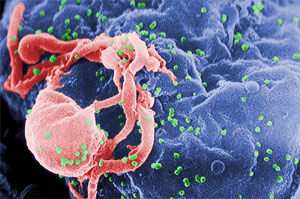|
A team of US scientists has suceeded in decoding the structure of an entire HIV genome for the first time, which will give the world a better insight into the viruses that causes AIDS in humans.  Researchers at the University of North Carolina at Chapel Hill decoded the complex HIV genome, the results of which, will have widespread implications for understanding how exactly the virus infects humans. Researchers at the University of North Carolina at Chapel Hill decoded the complex HIV genome, the results of which, will have widespread implications for understanding how exactly the virus infects humans.
The study, published in Nature, also opens the door for further research for accelerating the development of antiviral drugs. Kevin Weeks, Ph.D., a professor of chemistry in UNC's College of Arts and Sciences who led the study, said prior to this new work researchers had modeled only small regions of the HIV RNA genome. The HIV RNA genome is very large, composed of two strands of nearly 10,000 nucleotides each. By mapping the genetic structure of the virus, scientists will be able to develop more effective drugs to treat HIV, said Weeks. If replication of the virus is stopped or curtailed, there may be a possibility to even attack the virus before it gets an opportunity of sitting idle in the human body. HIV, like the viruses that cause influenza, hepatitis C and polio, carries its genetic information as single-stranded RNA rather than double-stranded DNA. The information encoded in DNA is almost entirely in the sequence of its building blocks, which are called nucleotides. But the information encoded in RNA is more complex, RNA is able to fold into intricate patterns and structures. These structures are created when the ribbon-like RNA genome folds back on itself to make three-dimensional objects. Weeks, who is also a member of the UNC Lineberger Comprehensive Cancer Center, and Joseph M. Watts, a chemistry postdoctoral fellow supported by the Lineberger Center, used technology developed by Weeks' lab to analyse the architecture of HIV genomes isolated from infectious cultures containing trillions of viral particles that were grown by Robert Gorelick, Ph.D., and Julian Bess of the National Cancer Institute. They then teamed up with UNC researchers in the College and the School of Medicine for further analysis. Christopher Leonard in the department of chemistry; Kristen Dang, Ph.D., from biomedical engineering; Ron Swanstrom, Ph.D., a professor of microbiology and immunology at UNC Lineberger; and Christina Burch, Ph.D., an associate professor of biology. They found that the RNA structures influence multiple steps in the HIV infectivity cycle. ''There is so much structure in the HIV RNA genome that it almost certainly plays a previously unappreciated role in the expression of the genetic code,'' Weeks said.
Swanstrom and Weeks note that the study is the key to unlocking additional roles of RNA genomes that are important to the lifecycle of these viruses in future investigations. ''One approach is to change the RNA sequence and see if the virus notices,'' Swanstrom said. ''If it doesn't grow as well when you disrupt the virus with mutations, then you know you've mutated or affected something that was important to the virus.'' ''We are also beginning to understand tricks the genome uses to help the virus escape detection by the human host,'' said Weeks. The study was supported by the National Institutes of Health and the National Cancer Institute. Hashim Al-Hashimi of the University of Michigan, Ann Arbor noted in an article in News and Views that structural biologists usually ''cut out'' the motifs formed by RNA and then ''zoom in to determine their three-dimensional structures in an attempt to further understand their function. However, Watts zoom out and provide an 'aerial view' of the secondary structure of the entire HIV-1 genome.''
|